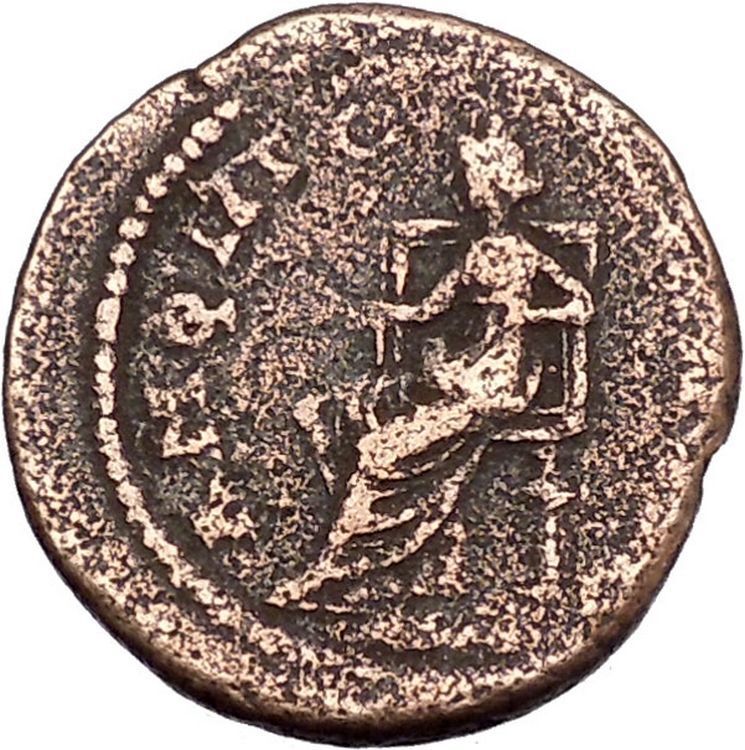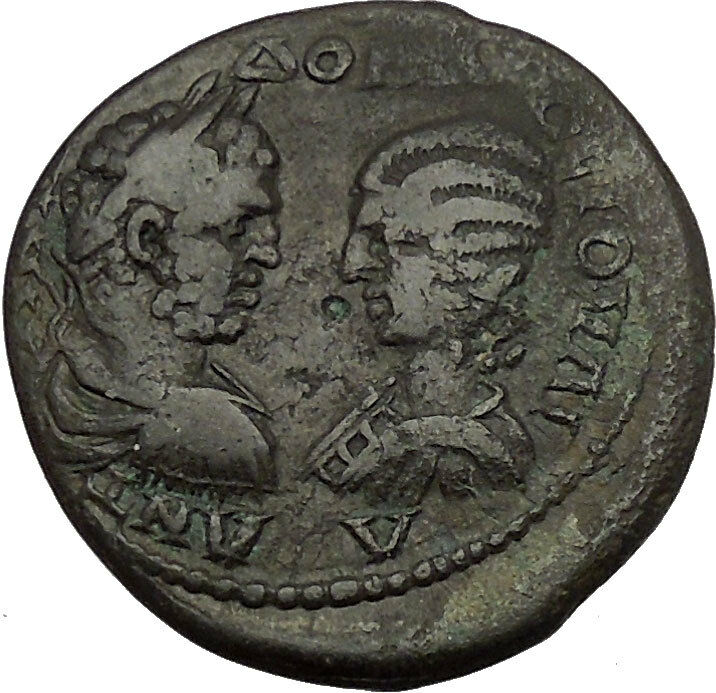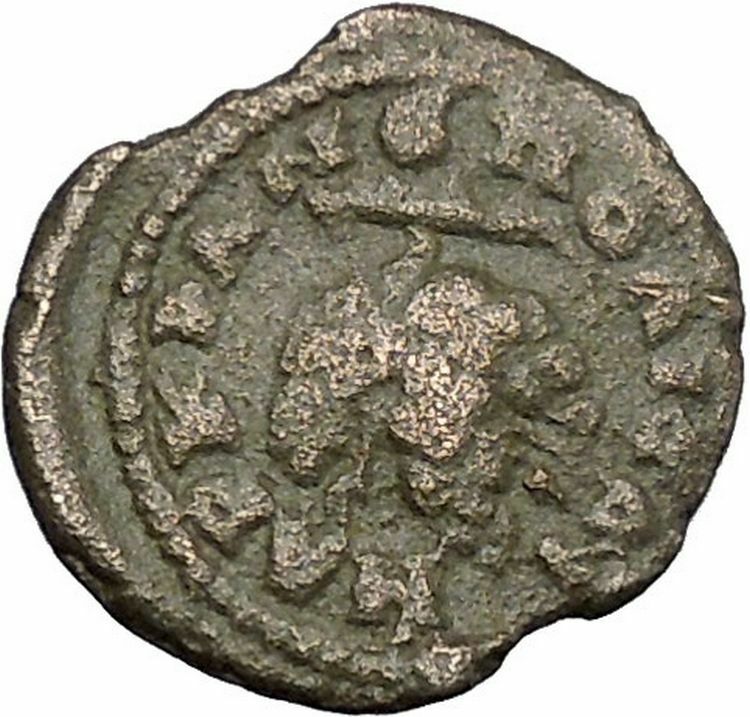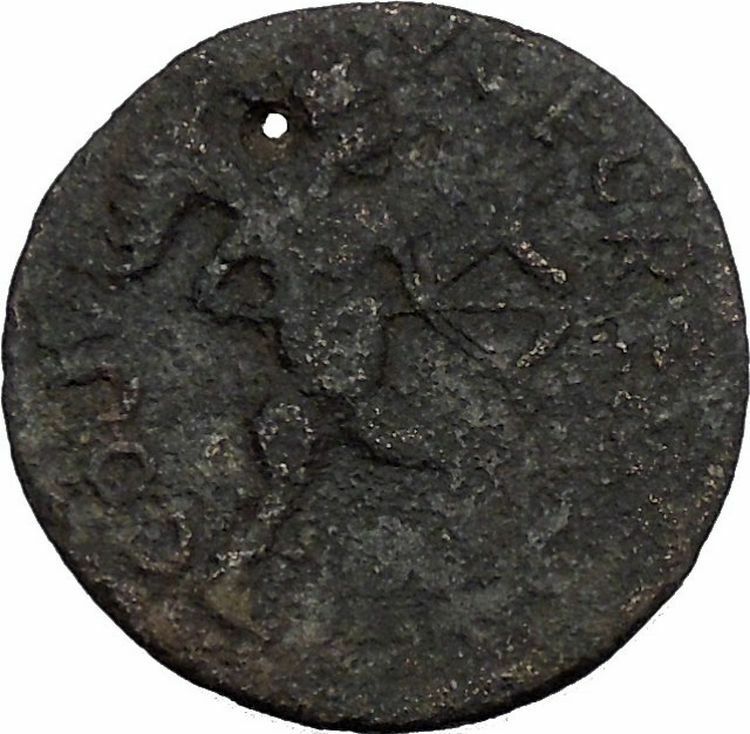|
Faustina II –
Roman Empress & Wife of
Emperor
Marcus Aurelius –
161-175 A.D. –
Bronze 17mm (3.24 grams) of
Amphipolis in
Macedonia
Reference: SNG ANS 191
ΦAYCTЄIN CЄBACTH, draped bust right.
ΑΜΦΙΠΟΛЄΙΤΩΝ, Artemis
Tauropolos riding bull right.
You
are bidding on the exact item pictured, provided with a
Certificate of Authenticity and Lifetime Guarantee of
Authenticity.
Artemis was one of the most widely venerated of
the Ancient Greek deities. Some scholars believe that
the name, and indeed the goddess herself, was originally
pre-Greek. Homer refers to her as Artemis Agrotera,
Potnia Theron
“Artemis of the wildland, Mistress of Animals”. In the
classical period of
Greek mythology
,
Artemis (Greek:
(nominative)
Ἄρτεμις, (genitive)
Ἀρτέμιδος) was
often
described as the daughter of
Zeus
and
Leto
, and the twin
sister of
Apollo
. She was the
Hellenic goddess of the hunt, wild animals, wilderness,
childbirth, virginity and young girls, bringing and
relieving disease in women; she often was depicted as a
huntress carrying a bow and arrows. The
deer
and the
cypress
were sacred to
her. In later Hellenistic times, she even assumed the
ancient role of
Eileithyia
in aiding
childbirth.
Artemis later became identified with
Selene
, a
Titaness
who was a
Greek moon goddess, sometimes depicted with a crescent
moon above her head. She was also identified with the
Roman goddess
Diana
, with the
Etruscan
goddess
Artume
, and with the
Greek or
Carian
goddess
Hecate
was an
Amphipolisancient
Greek
city
in the region once
inhabited by the
Edoni
people in the
present-day
periphery
of
Central Macedonia
. It
was built on a raised plateau overlooking the east bank
of the
river
Strymon
where it
emerged from Lake Cercinitis, about 3 m. from the
Aegean Sea
. Founded in
437 BC, the city was finally abandoned in the 8th
century AD. The present municipality Amfipoli, named
after the ancient city, occupies the site. Currently, it
is a municipality in the
Serres Prefecture
,
Central Macedonia
with
a population of 3,623 (2001 census).
Origins
Archaeology
has
uncovered remains at the site dating to approximately
3000 BC. Due to the strategic location of the site it
was fortified from very early.
Xerxes I
of Persia
passed during
his invasion of Greece of 480 BC and buried alive nine
young men and nine maidens as a sacrifice to the river
god. Near the later site of Amphipolis
Alexander I
of Macedon
defeated the
remains of Xerxes’ army in 479 BC.
Throughout the 5th century BC,
Athens
sought to
consolidate its control over Thrace, which was
strategically important because of its primary materials
(the gold and silver of the
Pangaion hills
and the
dense forests essential for naval construction), and the
sea routes vital for Athens’ supply of grain from
Scythia
. After a first
unsuccessful attempt at colonisation in 497 BC by the
Miletian
Tyrant
Histiaeus
, the
Athenians founded a first colony at Ennea-Hodoi (‘Nine
Ways’) in 465, but these first ten thousand colonists
were massacred by the
Thracians
. A second
attempt took place in 437 BC on the same site under the
guidance of
Hagnon
, son of
Nicias
.
The new settlement took the name of Amphipolis
(literally, “around the city”), a name which is the
subject of much debates about
lexicography
.
Thucydides
claims the
name comes from the fact that the Strymon flows “around
the city” on two sides; however a note in the
Suda
(also given in the
lexicon of
Photius
) offers a
different explanation apparently given by
Marsyas
, son of
Periander
: that a large
proportion of the population lived “around the city”.
However, a more probable explanation is the one given by
Julius Pollux
: that the
name indicates the vicinity of an
isthmus
. Furthermore,
the
Etymologicum Genuinum
Amphipolis subsequently became the main power base of
the Athenians in Thrace and, consequently, a target of
choice for their
Spartans
adversaries.
The Athenian population remained very much in the
minority within the city. An Athenian rescue expedition
led by strategist (and later historian) Thucydides had
to settle for securing
Eion
and could not
retake Amphipolis, a failure for which Thucydides was
sentenced to exile. A new Athenian force under the
command of
Cleon
failed once more
in 422 BC during a
battle
at which both
Cleon
and
Brasidas
lost their
lives. Brasidas survived long enough to hear of the
defeat of the Athenians and was buried at Amphipolis
with impressive pomp. From then on he was regarded as
the founder of the city and honoured with yearly games
and sacrifices. The city itself kept its independence
until the reign of the king
Philip II
despite
several other Athenian attacks, notably because of the
government of
Callistratus
of Aphidnae
.
Conquest
by the Romans
In 357 BC, Philip removed the block which Amphipolis
presented on the road to Macedonian control over Thrace
by conquering the town, which Athens had tried in vain
to recover during the previous years. According the
historian
Theopompus
, this
conquest came to be the object of a secret accord
between
Athens
and Philip II,
who would return the city in exchange for the fortified
town of
Pydna
, but the
Macedonian king betrayed the accord, refusing to cede
Amphipolis and laying siege to Pydna.
After the conquest by Philip II, the city was not
immediately incorporated into the kingdom, and for some
time preserved its institutions and a certain degree of
autonomy. The border of Macedonia was not moved further
east; however, Philip sent a number of Macedonians
governors to Amphipolis, and in many respects the city
was effectively ‘Macedonianized’. Nomenclature, the
calendar and the currency (the
gold stater
, installed
by Philip to capitalise on the gold reserves of the
Pangaion hills, replaced the Amphipolitan
drachma
) were all
replaced by Macedonian equivalents. In the reign of
Alexander
, Amphipolis
was an important naval base, and the birthplace of three
of the most famous Macedonian
Admirals
:
Nearchus
, Androsthenes[6]
and
Laomedon
Amphipolis became one of the main stops on the
Macedonian royal road (as testified by a border stone
found between
Philippos
and
Amphipolis giving the distance to the latter), and later
on the ‘Via
Egnatia’, the principal
Roman Road
which
crossed the southern Balkans. Apart from the ramparts of
the low town (see photograph), the gymnasium and a set
well-preserved frescoes from a wealthy villa are the
only artifacts from this period that remain visible.
Though little is known of the layout of the town, modern
knowledge of its institutions is in considerably better
shape thanks to a rich epigraphic documentation,
including a military ordinance of
Philip V
and an
ephebarchic
law from
the gymnasium. After the final victory of
Rome
over Macedonia in
a
battle
in 168 BC,
Amphipolis became the capital one of the four
mini-republics, or ‘merides’, which were created by the
Romans out of the kingdom of the
Antigonids
which
succeeded
Alexander’s
Empire in Macedon. These ‘merides’ were gradually
incorporated into the Roman client state, and later
province, of
Thracia
.
Revival
in Late Antiquity
During the period of
Late Antiquity
,
Amphipolis benefited from the increasing economic
prosperity of Macedonia, as is evidenced by the large
number of
Christian Churchess
that
were built. Significantly however, these churches were
built within a restricted area of the town, sheltered by
the walls of the
acropolis
. This has
been taken as evidence that the large fortified
perimeter of the ancient town was no longer defendable,
and that the population of the city had considerably
diminished.
Nevertheless, the number, size and quality of the
churches constructed between the fifth and sixth
centuries are impressive. Four
basilicas
adorned with
rich
mosaic
floors and
elaborate architectural sculptures (such as the
ram-headed
column
capitals – see
picture) have been excavated, as well as a church with a
hexagonal central plan which evokes that of the
basilica
St. Vitalis in
Ravenna
. It is
difficult to find reasons for such municipal
extravagance in such a small town. One possible
explanation provided by the historian
André Boulanger
is that
an increasing ‘willingness’ on the part of the wealthy
upper classes in the late Roman period to spend money on
local
gentrification
projects
(which he terms ‘’évergétisme’’,
from the Greek verb εύεργετέω,(meaning ‘I do good’) was
exploited by the local church to its advantage, which
led to a mass gentrification of the urban centre and of
the agricultural riches of the city’s territory.
Amphipolis was also a
diocese
under the
suffragan
of
Thessaloniki
– the
Bishop of Amphipolis is first mentioned in 533 AD.
From
the reduction of the urban area to the disappearance of
the city
The
Slavic invasions
of the
late 6th century gradually encroached on the
back-country Amphipolitan lifestyle and led to the
decline of the town, during which period its inhabitants
retreated to the area around the acropolis. The ramparts
were maintained to a certain extent, thanks to materials
plundered from the monuments of the lower city, and the
large unused cisterns of the upper city were occupied by
small houses and the workshops of artisans. Around the
middle of the 7th century AD, a further reduction of the
inhabited area of the city was followed by an increase
in the fortification of the town, with the construction
of a new rampart with pentagonal towers cutting through
the middle of the remaining monuments. The acropolis,
the
Roman bathss
, and
especially the Episcopal basilica were crossed by this
wall.
The city was probably abandoned in the eighth
century, as the last bishop was attested in 787. Its
inhabitants probably moved to the neighbouring site of
ancient
Eion
, port of
Amphipolis, which had been rebuilt and refortified in
the
Byzantine period
under
the name “Chrysopolis”.
This small port continued to enjoy some prosperity,
before being abandoned during the
Ottoman period
. The
last recorded sign of activity in the region of
Amphipolis was the construction of a fortified tower to
the north in 1367 by
Grand Primicier
Jean
and the
Stratopedarque
Alexis
to protect the land that they had given to the monastery
of Pantokrator on
Mount Athos
.
The site was rediscovered and described by many
travellers and archaeologists during the 19th century,
including E. Cousinéry (1831) (engraver), L. Heuzey
(1861), and P. Perdrizet (1894–1899). In 1934, M. Feyel,
of the
École française d’Athènes
,
led an
epigraphical mission
to
the site and uncovered the remains of a funeral lion (a
reconstruction was given in the, a publication of the
EfA which is available on line). However, excavations
did not truly begin until after the Second World War.
The
Greek Archaeological Society
under D. Lazaridis excavated in 1972 and 1985,
uncovering a necropolis, the rampart of the old town
(see photograph), the basilicas, and the acropolis.
Amphipolitans
-
Demetrius of Amphipolis
,
student of Plato’s
-
Zoilus
(400 BC-320
BC), grammarian, cynic philosopher
-
Pamphilus (painter)
,
head of
Sicyonian
school
and teacher of
Apelles
-
Aetion
, sculptor
-
Philippus of Amphipolis
,
historian
-
Nearchus
, admiral
-
Erigyius
, general
-
Damasias
[disambiguation
needed] of Amphipolis 320 BC
Stadion
Olympics
-
Hermagoras of Amphipolis
(c. 225 BC), stoic philosopher ,follower of
Persaeus
-
Xena
, the Warrior
Princess of Amphipolis.
Annia
Galeria Faustina Minor (((Minor Latin for
the younger), Faustina Minor or Faustina
the Younger

(February
16 between 125 and 130-175) was a daughter of
Roman Emperor
Antoninus Pius
and Roman Empress
Faustina the Elder
. She was a Roman Empress and wife
to her maternal cousin Roman Emperor
Marcus Aurelius
. Though Roman sources give a
generally negative view of her character, she was held
in high esteem by soldiers and her own husband and was
given divine honours after her death.
//
Biography
Faustina, named after her mother, was
her parents’ fourth and youngest child and their second
daughter; she was also their only child to survive to
adulthood. She was born and raised in
Rome
.
Her great uncle, the Emperor
Hadrian
, had arranged with her father for Faustina
to marry
Lucius Verus
. On February 25, 138, she and Verus
were betrothed.
Verus’ father
was Hadrian’s first adopted son and
his intended heir. However when Verus’ father died,
Hadrian chose Faustina’s father to be his second adopted
son, and eventually, he became Hadrian’s successor.
Faustina’s father ended the engagement between his
daughter and Verus and arranged for Faustina’s betrothal
to her maternal cousin,
Marcus Aurelius
; Aurelius was also adopted by her
father. On May 13, 145, Faustina and Marcus Aurelius
were married. When her father died on March 7, 161, her
husband and Lucius Verus succeeded to her father’s
throne and became co-rulers. Faustina was given the
title of
Augusta
and became Empress.
Unfortunately, not much has survived
from the Roman sources regarding Faustina’s life, but
what is available does not give a good report.
Cassius Dio
and the
Augustan History
accuse Faustina of ordering
deaths by poison and execution; she has also been
accused of instigating the revolt of
Avidius Cassius
against her husband. The Augustan
History mentions adultery with sailors, gladiators,
and men of rank. However, Faustina and Aurelius seem to
have been very close and mutually devoted. Her husband
trusted her and defended her vigorously against
detractors.
Faustina accompanied her husband on
various military campaigns and enjoyed the love and
reverence of Roman soldiers. Aurelius gave her the title
of Mater Castrorum or Mother of the Camp.
Between 170-174, she was in the north, and in 175, she
accompanied Aurelius to the east. However, these
experiences took their toll on Faustina, who died in the
winter of 175, after an accident, at the military camp
in Halala (a city in the
Taurus Mountains
in
Cappadocia
).
Aurelius grieved much for his wife
and buried her in the Mausoleum of Hadrian in Rome. She
was deified: her statue was placed in the Temple of
Venus in Rome and a temple was dedicated to her in her
honor. Halala’s name was changed to Faustinopolis
and Aurelius opened charity schools for orphan girls
called Puellae Faustinianae or ‘Girls of
Faustina’.[1]
The Baths of Faustina in
Miletus
are named after her.
In their thirty years of marriage,
Faustina bore Marcus Aurelius thirteen children:
-
Annia Aurelia Galeria Faustina
(147-after 165)
-
Gemellus Lucillae (died around
150), twin brother of Lucilla
-
Annia Aurelia Galeria
Lucilla
(148/50-182), twin sister of Gemellus,
married her father’s co-ruler
Lucius Verus
-
Titus Aelius Antoninus (born
after 150, died before 7 March 161)
-
Titus Aelius Aurelius (born after
150, died before 7 March 161)
-
Hadrianus (152-157)
-
Domitia Faustina (born after 150,
died before 7 March 161)
-
Fadilla
(159-after 211)
-
Annia Cornificia Faustina Minor
(160-after 211)
-
Titus Aurelius Fulvus Antoninus
(161-165), twin brother of Commodus
-
Commodus
(161-192), twin brother of Titus
Aurelius Fulvus Antoninus, later emperor
-
Marcus Annius Verus Caesar
(162-169)
- Vibia Aurelia Sabina (170-died before 217)
|










